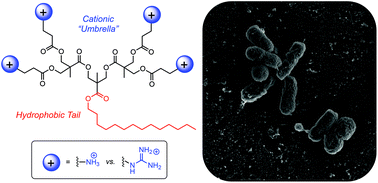Guanidium-functionalized cationic molecular umbrellas as antibacterial agents†
Abstract
We report the synthesis of cationic dendrons (1st and 2nd generations) with pendant alkyl chains of varying lengths (C8, C12, C14), which are classified as cationic molecular umbrellas. In each case, the dendron surface moieties were functionalized with guanidine groups, which are fully protonated in aqueous media of pH 7.4, lending cationic character to the solute. We found that these compounds are potent membrane-disrupting antibacterial agents with dose-dependent hemolytic activities. Confocal microscopy confirmed the permeabilization of E. coli and S. aureus cell membranes. A pyrene emission assay confirms that the dendrons are unimolecularly solvated at the concentrations relevant to their antibacterial activity, although they do aggregate at higher concentrations in aqueous buffer. Most importantly, when we compare the activity of these guanidinium-functionalized umbrellas to our previously published data on ammonium-functionalized analogues, we found no significant benefits to guanidinium relative to the ammoniums. The antibacterial activities are similar in all cases tested, and the highest selectivity index was found in the ammonium series, which stands in contrast to many other classes of antibacterial agents for which guanidinylation is typically associated with enhanced activity and selectivity.

- This article is part of the themed collection: Polymer Chemistry Pioneering Investigators 2021


 Please wait while we load your content...
Please wait while we load your content...